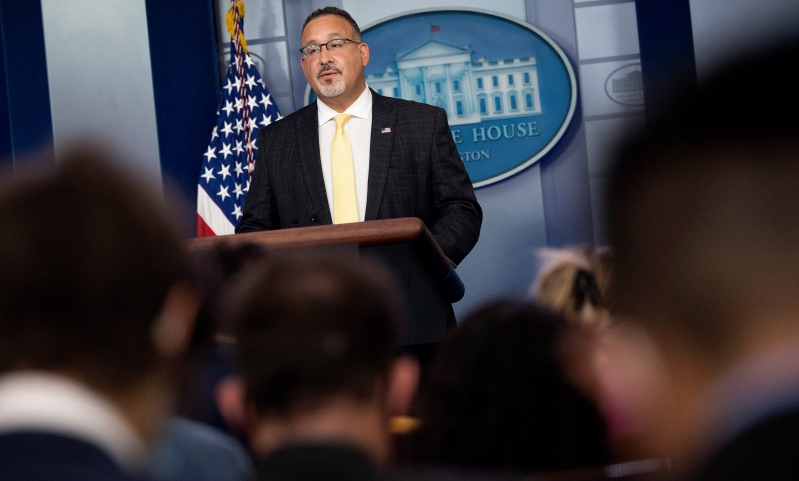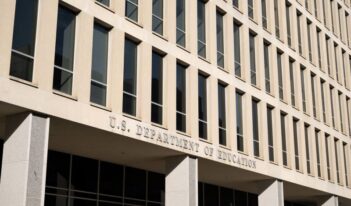
The Education Department’s new interpretation of federal law empowers states to protect student loan borrowers.
In the United States, more than 40 million borrowers collectively owe over $1.5 trillion in federal student loans.
The collection of much of this debt is handled by loan servicers—private companies assigned by the U.S. Department of Education. During the Trump Administration, the Education Department adopted an interpretation of the Higher Education Act of 1965 (HEA) and other federal laws that shielded loan servicers from state regulation.
In August, U.S. Secretary of Education Miguel Cardona replaced the Trump-era interpretation with one that confirms that states may prohibit loan servicers from using unfair or deceptive practices and may regulate other aspects of federal student loan servicing to protect borrowers.
Although the U.S. federal government guarantees and bears the risk for federal student loans, lenders have little contact with the federal government beyond submitting a Free Application for Federal Student Aid (FAFSA). Instead, borrowers interact almost exclusively with their loan servicer. In exchange for providing loan repayment plans, loan consolidation, and other administrative services, loan servicers receive payment for each loan they service. Loan servicers make more money when borrowers owe more and pay off their loans over long periods of time.
Federal student loan servicing has become a notable segment in the loan servicing industry. In recent years, however, federal student loan borrowers have accused loan servicers of putting profits ahead of borrowers by misrepresenting repayment options, pushing borrowers into forbearance, and not informing them of loan forgiveness programs.
Under the Trump Administration’s interpretation, the Education Department considered state laws concerning loan servicers invalid, including laws that required “licensure and oversight of student loan servicers” and prohibited “acts such as engaging in unfair, deceptive, or fraudulent acts or practices; misapplying payments; reporting inaccurate information to credit bureaus; or refusing to communicate with an authorized representative of the student loan borrower.”
But the new Education Department interpretation notes that multiple courts had determined that the Trump Administration’s interpretation lacked binding authority because it required additional analysis and was not thorough, consistent, or persuasive.
With its new interpretation, the Education Department has now not only emphasized that states have the legal authority to regulate several aspects of federal student loan servicing; it encourages states to do so and outlines how it will support states’ efforts.
Some student loan service industry groups, such as the Education Finance Council, argue that federal law should take precedence if it conflicts with state laws. The then-president of the Education Finance Council, Debra Chromy, reportedly expressed concern about the “patchwork of 50 different state laws” that servicers and borrowers would have to navigate if state law was not preempted.
Under the new interpretation, the Education Department makes it clear that although “federal law does preempt state regulation in certain narrow areas,” states can and should “regulate student loan servicing in many other ways” that are not preempted by the HEA.
The new interpretation provides several justifications for the Education Department’s new position. For instance, under general preemption principles, consumer protection is “traditionally occupied by the states” rather than the federal government, so federal claims of preemption in this area require a clear directive from the U.S. Congress.
In addition, the Education Department now rejects the previous administration’s reliance on field preemption—scenarios where federal laws govern the entire scope of the particular field of law and implicitly preclude state regulation. As the Department observes, no circuit court has found that field preemption applies to the HEA.
Furthermore, the current Education Department rejects the previous administration’s reliance on express preemption—where the wording of a statute explicitly preempts states. Although the HEA does expressly preempt certain areas of state law, “those provisions are limited and selective,” notes the Department. Indeed, some courts have ruled definitively that federal law does not “expressly” preempt state law claims against loan servicers that make affirmative misrepresentations to borrowers.
The Department’s new interpretation not only empowers states to regulate loan servicers, but it also seeks to facilitate coordination with “state partners to further enhance both servicer accountability and borrower protections.” In this way, the new interpretation restores the Education Department’s longstanding position on states’ ability to regulate loan servicers and marks a crucial step toward the Biden Administration’s aim to “renew partnerships with state and federal regulators.”
With this renewed federal support, states can now more readily oversee federal student loan servicers to protect their residents against predatory practices. If well-implemented, state regulation may better align loan servicers’ private interests with those of federal student loan borrowers.



